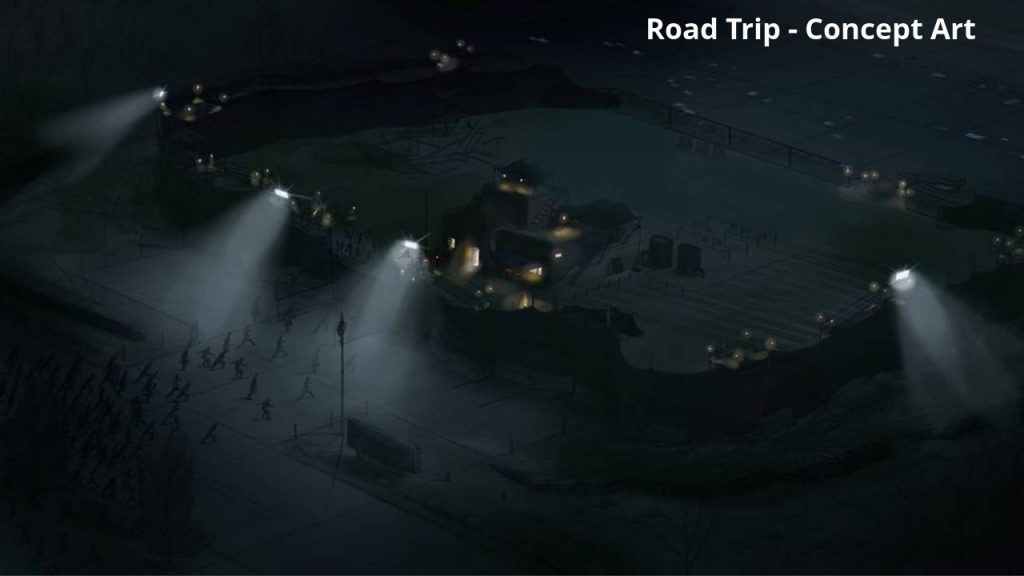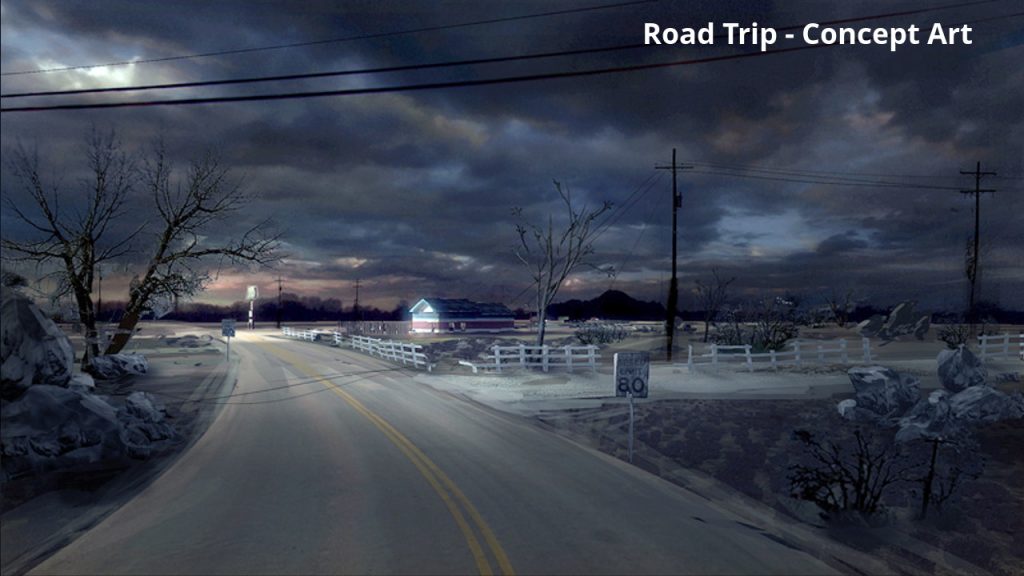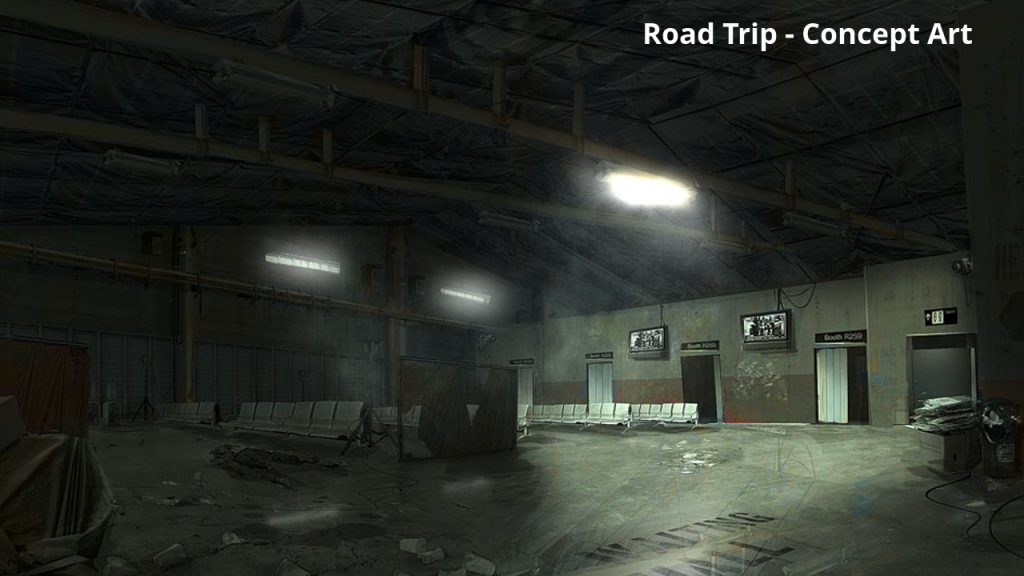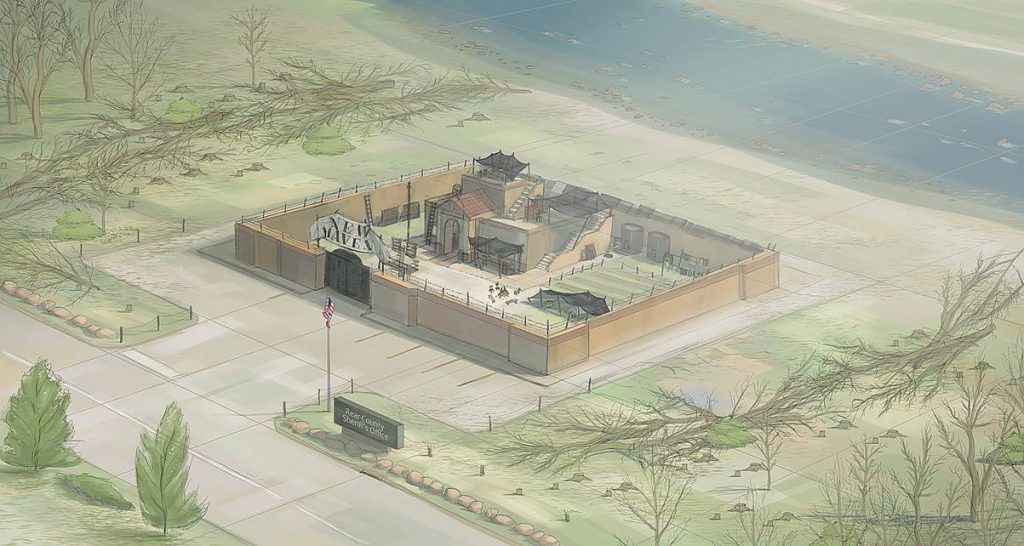Road Trip is a cancelled zombie-apocalypse adventure game that was in development in 2009 / 2010 by French studio Hydravision Entertainment (mostly known for the popular survival horror game Obscure) planned to be released on Xbox 360 and Playstation 3. Initially known as Project T, the game was meant to be a more mature and open-ended take on the “zombie survival” genre, with a gameplay mechanic similar to State of Decay (released only 4 years later) and a characters-driven storyline, with a strong, non-romantic relationship between the two main protagonists, a man and a woman, somehow similar to what Naughty Dog did many years later in The Last Of Us. Road Trip was ambitious in scope and was likely Hydravision’s last chance for success, as the studio went bankrupt in 2012.
Popular books, comics and movies such as The Walking Dead, World War Z, 28 Days Later, Life After People and I Am Legend were the main influences for Road Trip. The studio wanted to create an open ended survival-horror game focused on action, immersion, and the feeling of freedom, while keeping pressure on players as much as possible, to surprise them with huge zombie hordes.
Road Trip was meant to be different from other third person shooters in that the player was going to have to deal with a constant sense of omnipresent danger. Instead of being in a shooting gallery and just walking toward the enemies, the player would be pushed into difficult situations and forced to figure out the best way to deal with the situation. Players would have never been completely safe in Road Trip: infected could be already roaming in the areas or appear suddenly. Zombies could pop up at anytime and from anywhere like open doorways, through windows, and even from the ceiling. These monsters would never give up, and they would hunt their prey aggressively as they were able to scale most obstacles.
Luckily players could use the environment to protect themselves, taking refuge inside a building and barricading it (pushing furniture in front of an exit to block it, closing and locking doors, windows, shutters, nailing wood boards on exits, etc.), slowing the enemies down while fleeing or using various items to help kill dozens of zombies at once (shooting a gas tank, wired grenades, etc.).
In this post-apocalyptic zombie world cities have been deserted (they are too dangerous, plus diseases are spreading quickly because of all the rotting flesh). A small proportion of the population has managed to adapt and survive in suburban areas, but most died in the first few days. There’s no electricity to be found, but petrol is still usable, providing you can find it in abandoned gas stations.
Hydravision wanted to make Road Trip a captivating experience with minimal interface during gameplay and minimizing game tropes such as stage / boss structure, visible weak points and so on. As time passed in-game NPC and enemies behavior would also change to suit the situation.
The game’s main objective was to organize the survival of a small group of characters by building up a camp and defending it from zombies and rival factions. Players would have to accomplish various missions around many different areas near the camp to achieve this ultimate goal, exploring abandoned towns, shops and desert roads. The world of Road Trip was structured in a network of levels which could have been explored at any time, built around the camp, which acted as a main hub.
Travel between areas was possible thanks to another important mechanic of the game – an upgradable Van – which would have been used to get around. The van could also be used as a weapon to run over hordes of zombies, and it served as a temporary base to restore health when out exploring. The Van could have been upgraded with different abilities, like a ladder to climb on the roof and reach higher places, a bulbar for ramming and breaking down specific bits of the scenery, or a winch to rip unlockable door apart and to move objects. The vehicle was also used as player storage, as the inventory space was limited. While players were free to drive around each single area, to move between them there would have been a short cinematic showing highlights of the road trip.
Big cities were not planned to be in the game due to production cost, but it was somehow justified by the situation as people would try to stay away from dangerous places with too many infected. The world planned for the game was set far away in some kind of desert area, helping to convey the need for players to be lost in the middle of nowhere. The map would be composed of main and secondary areas, depending on their size: a secondary area would have just one to three buildings, whereas a main area would have been much bigger (more buildings or bigger ones, such as schools, stadiums, churches or gas stations).
The story of Road Trip would have followed TJ, a post-outbreak loner, and Mia, an infected girl, as they would attempt to rebuild a society that may have collapsed for good reason. The following is the proposed intro of the game, that introduced TJ to the players:
“Two young survivors are taken to a warehouse to practice shooting by a more experienced character.
All hell breaks loose when they’re attacked by runners (zombies). The leader flees in the vehicle, and eventually both PCs are overpowered.
We hear shots ring out, and TJ approaches the fallen survivors. It’s clear he didn’t know them. He begins to scavenge what he can from the bodies, when he hears one of them groan. He walks over and checks the badly injured girl. She asks him to help her. He stands up and walks away. He picks up the girl’s friend’s weapon and hands it to her. He turns away and we hear the gunshot.
Roll title sequence and opening narration.”
An important aspect of Road Trip’s gameplay and story would have been the relationship and cooperation between TJ and Mia, following the mutual support of both characters, helping each other with their strengths and weaknesses. This was planned to be a realistic connection between two people in a dangerous world, without any trivial romance. More details about Road Trip’s main plot and characters can be read in this early draft:
“Six weeks after the outbreak of a rabies-like human virus, TJ comes across Mia, a troubled girl in near catatonic state. He travels with her to a small group of survivors, lead by the charismatic Mason, who are attempting to fortify an isolated sheriff’s office, and re-establish society.
Prolonged survival is not the only challenge facing the pair as it becomes apparent Mia has been infected by a unique variant of the virus, rendering her life easier to keep a hold of than her humanity.
TJ must balance this secret against the needs of the growing group, a problem brought sharply into focus when Mason is killed and he is forced to take control. Though he may make for a more level headed leader, TJ can’t help but recall a simpler time when it was just him, the infected, and the road ahead. They’ve been so focused on clinging to what remains of their society that they never stopped to ask whether that was what they really wanted.
These challenges are overshadowed by a second survivor camp in the nearby area, to which one of their number has already defected. Stories from the road tell of a large band of raiders who see the surrounding area as their personal playground, and all attempts to allay this suspicion are in vain. When they hear of an impending attack, TJ and his companions have no choice but to make a preemptive strike.
The general idea would be that the other camp is, while certainly barbaric in some ways (capital punishment, arena fighting etc), by no means evil (raping and pillaging). In fact, they are simply doing their best to rebuild society. This fact, however, gets lost among the gossip. Tales from the road, mistaken identity, confusion and suspicion all result in both camps seeing one another as a threat – and, eventually, TJ’s camp strikes first.
Sabotaging the other group’s defenses and watching as the infected pour in proves easier than clearing out the newly infected the following day – but the camp sits in an unrivaled location and can’t be ignored. It’s only when the last of the sick has been put down that they have a chance to examine the society they’ve extinguished – only then that they realize these people were not the threat they appeared to pose. There is evidence of barbarism, for certain, but also of community. Of families. Of a vain attempt to cling to a few remnants of a dead society. And it has cost these people their lives.
For TJ, this is only symptomatic of a more fundamental illness in human society, and he’s sick of looking for a cure. He can’t see a future where human society doesn’t destroy itself, and he realizes his time alone, on the road, has been the most honest time of his life. He resolves to leave the other survivors to the society they have won for themselves and becomes, like Mia, an outcast. Together they will face whatever challenges lie ahead – better to die on the road than to live in a lie.
Yes, mistakes have been made. No, things aren’t necessarily alright. But maybe, between the two of them, they can find a way to deal with that. Because, regardless of everything else, if there’s one thing the zombie apocalypse should teach us, it’s that life is worth living.”
Mia’s strange infection would develop and change through the course of the game, players would need to avoid her crisis managing her stress and mental health (avoiding shocking scenes, claustrophobia, fear of the dark, loneliness / isolation, etc.). She could have been able to relax by staying in the Van, talking to another character and so on. Initially Mia would try to hide her infection to the group using clothes and bandages, but later it would become more evident and she wouldn’t be able to conceal it: NPCs in the camp would then react in different ways depending on their personalities.
During gameplay players would have been able to use both TJ or Mia. The woman would have more developed senses, feeling when and where enemies would appear, their behavior and weakness. TJ instead could have been able to set traps and barricades, repair and customize the Van, hold doors against enemies, grab heavy objects, use 2 handed weapons, aim more precisely and use his leadership / diplomacy skills (talking to the survivors, giving orders). Players would have to use both characters and their specific skills to have a chance to survive in this post-zombie-apocalypse world. Throughout the game TJ and Mia would have been able to rescue other survivors and to integrate them in their camp, a varied group of people with lots of different personalities and conflicting interests.
The focus of the game was to create a safe haven, saving more people (recruiting useful survivors like farmers and engineers) and organizing better defenses (weapons cache, shelters, etc.). Central plot progression would revolve around the construction of this camp and the people inside it. The objectives were related to the plot (searching for food / water, meeting or saving a survivor, finding clues about the enemy’s’ behavior, clearing the road, protecting the camp from a zombie crowd, etc.) and usually given at the camp by talking to the NPCs or by cut-scenes. Some side missions could also have been obtained at other places – like going from mission to mission without heading back to the camp.
Work on Road Trip started around mid-2009 with a small team of about 10 people: in just a few months they were able to create a couple of gameplay prototypes, greybox level designs in Unreal Engine, and a vertical slice of a gas station with zombies you could fight or avoid using stealth. It was the first Hydravision game made with Unreal so the team needed to learn what they could do, and how. This early prototype was self-funded by Hydravision but they hoped to gather publishers’ attention and sign a deal as soon as possible, maybe with Playlogic which they already worked with to publish Obscure 2 in Europe and to help with development of Fairytale Fights.
Road Trip had a lot of potential and from what we know it seems like the team was quite excited to work on such an interesting concept, but unfortunately they never found a publisher to fully fund development. Playlogic was buried in debts and were not able to fund new games: in august 2010 they officially closed down for bankruptcy, after failing to turn a profit when their latest games (Fairytale Fights, Vertigo and Infernal) sold way less than expected.
When Hydravision tried to pitch the game at various gaming events, other publishers told them that the game was way too ambitious for the size of their team and the money they asked for. Such an open ended zombie survival world with gameplay mechanics and a characters-driven plot predating titles like State of Decay and The Last Of Us was too ahead of its time to be greenlighted. After a year of design and gameplay experiments, in early/mid 2010 the game was finally cancelled.
The Road Trip team was moved around to help with other games, such as Obscure, a side-scrolling 4-players beat ‘em-up planned for 3DS, PSN, Xbox Live Arcade and Steam, officially announced in August 2012. Unfortunately it was already too late for the company: near the end of 2012 Hydravision went bankrupt and the studio was shut down, vanishing forever along with a good number of lost games we’ll never play. We can only hope that with this article the memory of Road Trip could be preserved, to hold its place in the unseen side of gaming history.
What do you think about this unseen game? Give your vote!
Would you like to add more info, screens or videos to this page? Add a comment below!
- Dead Unity [PC / PSX – Cancelled] - 04-01-2025
- Dragonkind [XBOX/PS2 – Cancelled] - 02-12-2023
- Damnation: Hell Breaks Loose [PC – Prototype] - 07-10-2023







